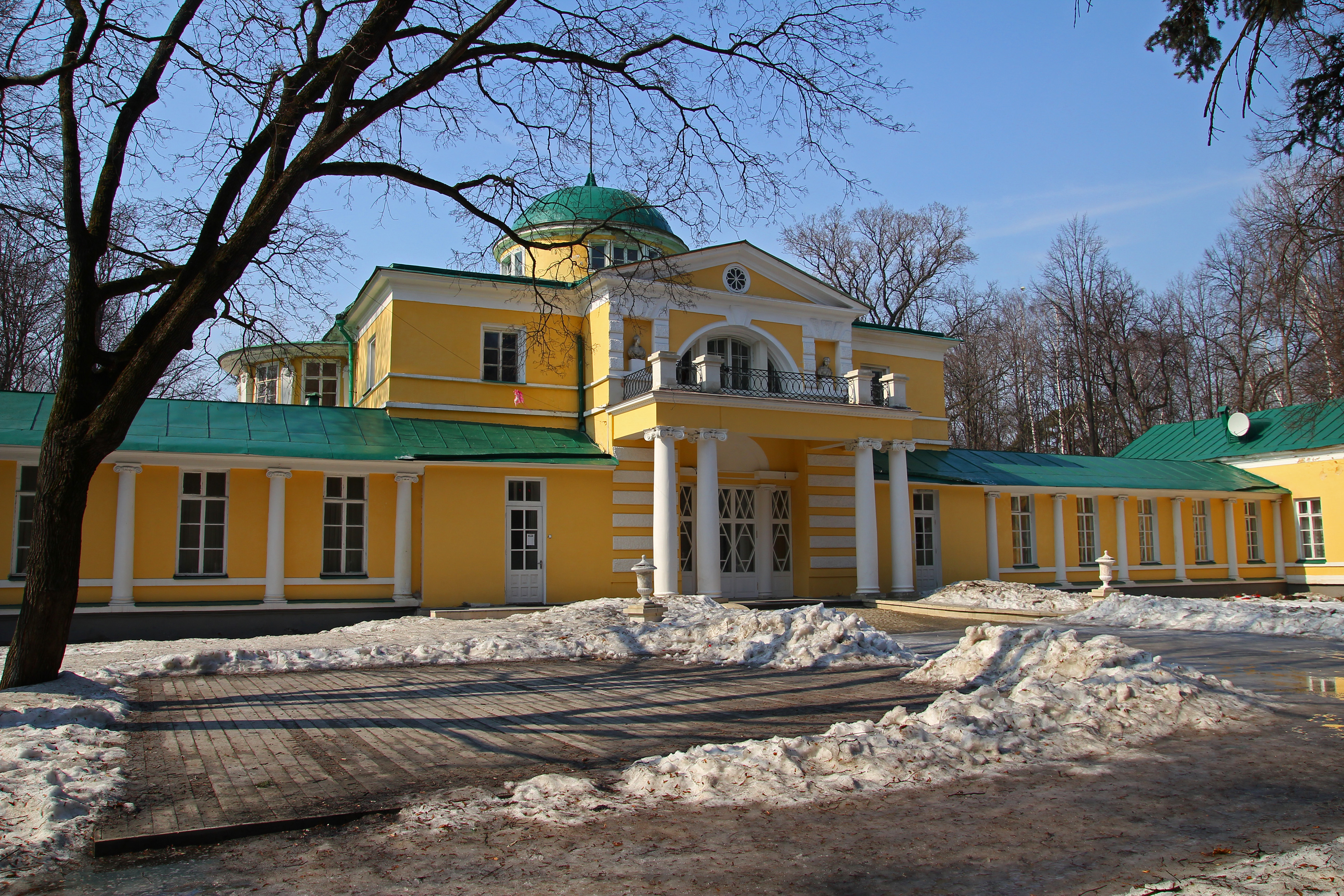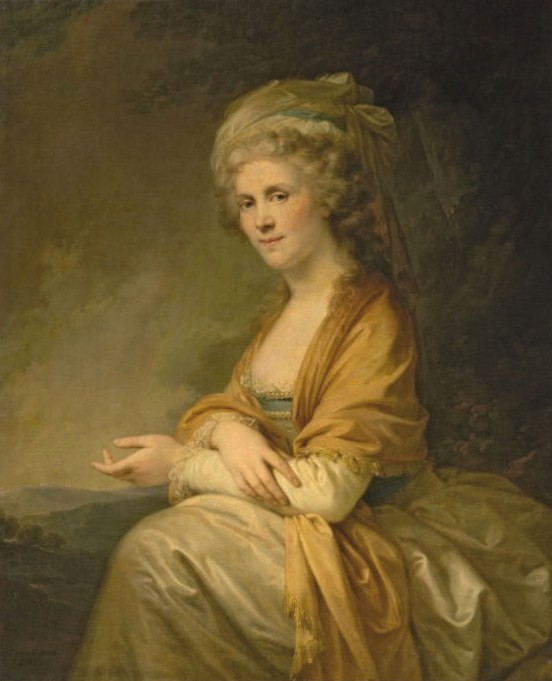|
Bratsevo
Brattsevo (russian: Бра́тцево) is an area in Yuzhnoye Tushino District of North-Western Administrative Okrug of Moscow, Russia; formerly a country estate and a village. It is located near the confluence of the Bratovka and the Skhodnya Rivers. History For the first time mentioned in a last will dated 1565. From 1657 the village owned by a boyar Bogdan Khitrovo, who built there stone church of Intercession of the Virgin, preserved to our time. At that time (1680), in Brattsevo was 24 peasant yards and 49 residents. After the death of Khitrovo and his widow Maria Ivanovna, the village has been received by Cyril Naryshkin, relative of Peter the Great on his mother (1695). Naryshkins owned of Brattsevo nearly a century. In 1780 the village was bought from the daughters of Cyril Naryshkin be Count Alexander Stroganoff, who immediately conveyed Brattsevo to his wife Catherine Petrovna. Soon after Count Stroganoff divorced the Countess because of her romance with Ivan Rims ... [...More Info...] [...Related Items...] OR: [Wikipedia] [Google] [Baidu] |
Yuzhnoye Tushino District
Yuzhnoye Tushino District (russian: Южное Тушино райо́н, lit. ''South Tushino'') is an administrative district (raion) of North-Western Administrative Okrug, and one of the 125 raions of Moscow, Russia. History Before 1960 district territories was part of Moscow oblast. It had villages Petrovo and Zakharkovo and Bratsevo mansion. The first wave of mass housing in the district began in the 1940-1950s as a part of the extending city Tushino. At that time, it was built along the streets of neighborhoods Skhodnenskaya (Skhodnya), Lodochnaya (Boat) and Okruzhnaya (Circle), but is currently under a mass demolition of these buildings and the construction in their place, modern high-rise buildings. The next wave of construction took place in the 1960-1970s, When neighborhoods were built along the boulevards Yana Raynisa (named after Janis Rajnis) and Khimkinski (after Khimka river, now this boulevard is near Khimkinskoye reservoir), Aerodromnaya (Tushino airport) and Tur ... [...More Info...] [...Related Items...] OR: [Wikipedia] [Google] [Baidu] |
Bratzevo Estate 01
Brattsevo (russian: Бра́тцево) is an area in Yuzhnoye Tushino District of North-Western Administrative Okrug of Moscow, Russia; formerly a country estate and a village. It is located near the confluence of the Bratovka and the Skhodnya Rivers. History For the first time mentioned in a last will dated 1565. From 1657 the village owned by a boyar Bogdan Khitrovo, who built there stone church of Intercession of the Virgin, preserved to our time. At that time (1680), in Brattsevo was 24 peasant yards and 49 residents. After the death of Khitrovo and his widow Maria Ivanovna, the village has been received by Cyril Naryshkin, relative of Peter the Great on his mother (1695). Naryshkins owned of Brattsevo nearly a century. In 1780 the village was bought from the daughters of Cyril Naryshkin be Count Alexander Stroganoff, who immediately conveyed Brattsevo to his wife Catherine Petrovna. Soon after Count Stroganoff divorced the Countess because of her romance with Ivan Rims ... [...More Info...] [...Related Items...] OR: [Wikipedia] [Google] [Baidu] |
Northern Sea Route
The Northern Sea Route (NSR) (russian: Се́верный морско́й путь, ''Severnyy morskoy put'', shortened to Севморпуть, ''Sevmorput'') is a shipping route officially defined by Russian legislation as lying east of Novaya Zemlya and specifically running along the Russian Arctic coast from the Kara Sea, along Siberia, to the Bering Strait. To be more precise, The Northern Sea Route crosses the seas of the Arctic Ocean (Kara Sea, Laptev Sea, East Siberian Sea, and Chukchi Sea). Administratively, in the west the NSR is bounded by the western entrances to the Novaya Zemlya straits and by the meridian running north from Cape Zhelaniya, and in the east, in the Bering Strait, it is bounded by the parallel of 66 ° N and the meridian of 168 ° 58′37 ″ W. The entire route lies in Arctic waters and within Russia's exclusive economic zone (EEZ). Parts are free of ice for only two months per year. The overall route on Russia's side of the Arctic between No ... [...More Info...] [...Related Items...] OR: [Wikipedia] [Google] [Baidu] |
Sovkhoz
A sovkhoz ( rus, совхо́з, p=sɐfˈxos, a=ru-sovkhoz.ogg, abbreviated from ''советское хозяйство'', "sovetskoye khozyaystvo (sovkhoz)"; ) was a form of state-owned farm in the Soviet Union. It is usually contrasted with kolkhoz, which is a collective-owned farm. Just as the members of a kolkhoz were called "kolkhozniks" or "kolkhozniki" (колхозники), the workers of a sovkhoz were called "sovkhozniki" (совхозники). History Soviet state farms began to be created in 1918Padalka, S. "Radhosps (РАДГОСПИ)' . ''Encyclopedia of History of Ukraine''. as an ideological example of "socialist agriculture of the highest order". Kolkhozes, or collective farms, were regarded for a long time as an intermediate stage in the transition to the ideal of state farming. While kolkhozy were typically created by combining small individual farms together in a cooperative structure, a sovkhoz would be organized by the state on land confiscated fr ... [...More Info...] [...Related Items...] OR: [Wikipedia] [Google] [Baidu] |
Revolutionary Military Council
The Revolutionary Military Council (russian: Революционный Военный Совет, Revolyutsionny Voyenny Sovyet, Revolutionary Military Council), sometimes called the Revolutionary War CouncilBrian PearceIntroductionto Fyodor Raskolnikov s "Tales of Sub-lieutenant Ilyin." or ''Revvoyensoviet'' (), was the supreme military authority of Soviet Russia and later the Soviet Union. It was instituted on September 2, 1918 by decree of the All-Russian Central Executive Committee (VTsIK), known as the "Decree Declaring the Soviet Republic Military Camp". Prior to ''Revvoyensoviet'', the two main military authorities had been the Supreme Military Council (, ') and the operations division of the People's Commissariat on War and Navy Affairs. The decree put all fronts and military organizations under the command of the chairman of ''Revvoyensoviet'', with a commander-in-chief second-in-line to the chairman to lead strategic and military operations stateside. The chairma ... [...More Info...] [...Related Items...] OR: [Wikipedia] [Google] [Baidu] |
State Historical Museum
The State Historical Museum ( Russian: Государственный исторический музей, ''Gosudarstvenny istoricheskiy muzyey'') of Russia is a museum of Russian history The history of Russia begins with the histories of the East Slavs. The traditional start-date of specifically Russian history is the establishment of the Rus' state in the north in 862, ruled by Varangians. Staraya Ladoga and Novgorod became ... located between Red Square and Manezhnaya Square, Moscow, Manege Square in Moscow. The museum's exhibitions range from relics of prehistoric tribes that lived in the territory of present-day Russia, to priceless artworks acquired by members of the Romanov dynasty. The total number of objects in the museum's collection numbers in the millions. Description The place where the museum now stands was formerly occupied by the Principal Medicine Store, built by order of Peter I of Russia, Peter the Great in the Moscow baroque style. The museum was f ... [...More Info...] [...Related Items...] OR: [Wikipedia] [Google] [Baidu] |
Red Guards (Russia)
, war=The Russian Revolution of 1917 and Russian Civil War , image= , caption= Red flags were used by guards in several modifications and variations , active=1917–1918(became core units of the Red Army) , ideology=Communism , position=Far-left , leaders= RSDLP(b) and Soviets , clans= , headquarters=Every major city , area=Russian Soviet Federative Socialist Republic and Russian Republic , size= , partof=Red Army (since January 1918) , predecessor= , allies= several communist states , opponents= Russian Provisional Government White Movement Entente Pro-independence movements in Russian Civil War , battles=October RevolutionRussian Civil War Red Guards (russian: Красная гвардия) were paramilitary volunteer formations consisting mainly of factory workers, peasants, cossacks and partially of soldiers and sailors for "protection of the soviet power". Red Guards were a transitional military force of the collapsing Imperial Russian Army and the base formations of Bolsh ... [...More Info...] [...Related Items...] OR: [Wikipedia] [Google] [Baidu] |
Ivan Shishkin
Ivan Ivanovich Shishkin (russian: Ива́н Ива́нович Ши́шкин; 25 January 1832 – 20 March 1898) was a Russian landscape painter closely associated with the Peredvizhniki movement. Biography Shishkin was born to a Russian merchant family in Yelabuga of Vyatka Governorate (today Republic of Tatarstan) and graduated from the Kazan gymnasium. Then he studied at the Moscow School of Painting, Sculpture and Architecture for four years. After that, he attended the Saint Petersburg Imperial Academy of Arts from 1856 to 1860 and graduated with the highest honours and a gold medal. He received the imperial scholarship for his further studies in Europe. Five years later Shishkin became a member of the Imperial Academy in St. Petersburg and was professor of painting from 1873 to 1898. At the same time, Shishkin headed the landscape painting class at the Highest Art School in St. Petersburg. For some time, Shishkin lived and worked in Switzerland and Germany on schola ... [...More Info...] [...Related Items...] OR: [Wikipedia] [Google] [Baidu] |
Andrea Palladio
Andrea Palladio ( ; ; 30 November 1508 – 19 August 1580) was an Italian Renaissance architect active in the Venetian Republic. Palladio, influenced by Roman and Greek architecture, primarily Vitruvius, is widely considered to be one of the most influential individuals in the history of architecture. While he designed churches and palaces, he was best known for country houses and villas. His teachings, summarized in the architectural treatise, ''The Four Books of Architecture'', gained him wide recognition. The city of Vicenza, with its 23 buildings designed by Palladio, and 24 Palladian villas of the Veneto are listed by UNESCO as part of a World Heritage Site named City of Vicenza and the Palladian Villas of the Veneto. The churches of Palladio are to be found within the "Venice and its Lagoon" UNESCO World Heritage Site. Biography and major works Palladio was born on 30 November 1508 in Padua and was given the name Andrea di Pietro della Gondola. His father, Pietro, ... [...More Info...] [...Related Items...] OR: [Wikipedia] [Google] [Baidu] |
Villa Capra "La Rotonda"
Villa La Rotonda is a Renaissance villa just outside Vicenza in northern Italy designed by Italian Renaissance architect Andrea Palladio. The villa's correct name is Villa Almerico Capra Valmarana, but it is also known as "La Rotonda", "Villa Rotonda", "Villa Capra", and "Villa Almerico Capra". The name ''Capra'' derives from the Capra brothers, who completed the building after it was ceded to them in 1592. Along with other works by Palladio, the building is conserved as part of the World Heritage Site "City of Vicenza and the Palladian Villas of the Veneto". Inspiration In 1565 a priest, Paolo Almerico, on his retirement from the Vatican (as referendario apostolico of Pope Pius IV and afterwards Pius V), decided to return to his home town of Vicenza in the Venetian countryside and build a country house. This house, later known as 'La Rotonda', was to be one of Palladio's best-known legacies to the architectural world. Villa Capra may have inspired a thousand subsequent buildin ... [...More Info...] [...Related Items...] OR: [Wikipedia] [Google] [Baidu] |
Andrey Voronikhin
Andrey (Andrei) Nikiforovich Voronikhin (russian: Андрей Никифорович Воронихин) (28 October 1759, Novoe Usolye, Perm Oblast – 21 February 1814, Saint Petersburg) was a Russian architect and painter. As a representative of classicism he was also one of the founders of the monumental Russian Empire style. Born a serf of the Stroganov family, he is best known for his work on Kazan Cathedral in Saint Petersburg. Andrey Voronikhin was born in the village of Novoa Usolye (now Perm Krai) to a family who were the serfs of count Alexander Sergeyevich Stroganov, a longtime President of the Imperial Academy of Arts. It is generally believed that he was fathered by Alexander Stroganov. Voronikhin trained in painting in the workshop of Ural icon painter Gabriel Yushkov. The talents of his youth attracted Stroganov's attention, and in 1777 the count sent Voronikhin to study in Moscow. Among his teachers were Vasili Ivanovich Bazhenov and Matvey Fyodorovich Kazako ... [...More Info...] [...Related Items...] OR: [Wikipedia] [Google] [Baidu] |



.jpg)


